
Francisco José de Goya y Lucientes was a Spanish romantic painter and printmaker. He is considered the most important Spanish artist of the late 18th and early 19th centuries. His paintings, drawings, and engravings reflected contemporary historical upheavals and influenced important 19th- and 20th-century painters. Goya is often referred to as the last of the Old Masters and the first of the moderns.

Maria del Rosario Weiss Zorrilla was a Spanish painter and engraver best known for portraits. She was the goddaughter of Francisco de Goya and lived with him during his final years when her mother was his maid. Over seventy of her drawings, preserved at the Hispanic Society of America, were once attributed to Goya but, in 1956, the art historian José López-Rey demonstrated conclusively that they were hers.
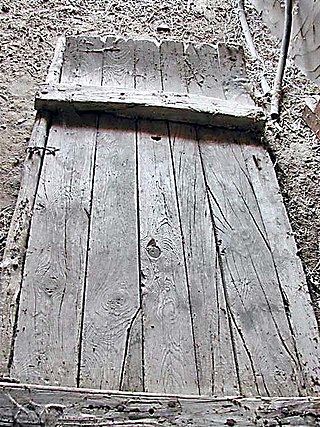
A threshing board, also known as threshing sledge, is an obsolete agricultural implement used to separate cereals from their straw; that is, to thresh. It is a thick board, made with a variety of slats, with a shape between rectangular and trapezoidal, with the frontal part somewhat narrower and curved upward and whose bottom is covered with lithic flakes or razor-like metal blades.

The Sleep of Reason Produces Monsters or The Dream of Reason Produces Monsters is an aquatint by the Spanish painter and printmaker Francisco Goya. Created between 1797 and 1799 for the Diario de Madrid, it is the 43rd of the 80 aquatints making up the satirical Los caprichos.
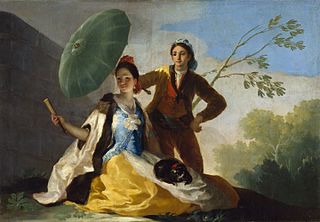
The Parasol is one of a cartoon series of oil on linen paintings made by the painter Francisco Goya. This series of paintings was specifically made in order to be transformed into tapestries that would be hung on the walls of the Royal Palace of El Pardo in Madrid, Spain. The tapestries showed serene events in everyday life, which made them a nice addition to the dining room of Prince and Princess of Asturias—the future King Charles IV and Maria Luisa of Parma. The queen called on Goya because she wanted to decorate the dining room with cheerful scenes; The Parasol and the other tapestry paintings were Goya's response to this request. The painting is currently located in the Museo del Prado in Madrid as is another in the series, Blind man's bluff.

Blind Man's Bluff is one of the Rococo oil-on-linen cartoons produced by the Spanish artist Francisco de Goya for tapestries for the Royal Palace of El Pardo. The painting and the previous skectch are held in the Museo del Prado, in Madrid.
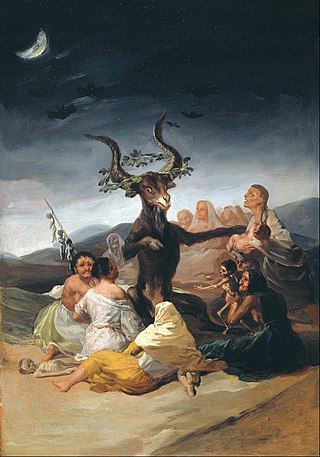
Witches' Sabbath is a 1798 oil painting on canvas by the Spanish artist Francisco Goya. Today it is held in the Museo Lázaro Galdiano, Madrid.
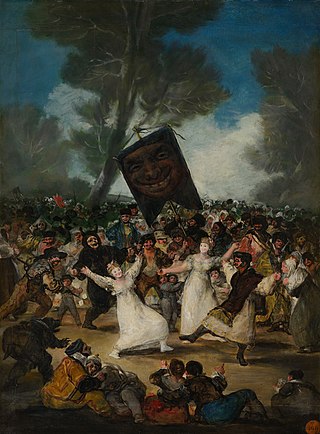
The Burial of the Sardine is an oil-on-panel painting by Spanish artist Francisco Goya, usually dated to the 1810s. It is held at the Real Academia de Bellas Artes de San Fernando, in Madrid.

The Lázaro Galdiano Museum is an art museum in Madrid, Spain. It houses the art collection of José Lázaro Galdiano. The museum was inaugurated on 27 January 1951.

The Royal Tapestry Factory is a factory making tapestries in Madrid, Spain, which was founded in 1720 and is still in operation.
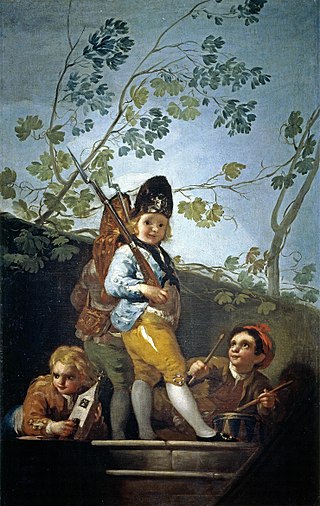
Boys Playing Soldiers is a 1778-79 tapestry cartoon by Francisco of Goya conceived for the bedroom of the Princes of Asturias in the Royal Palace of El Pardo. It is presently exhibited in the Museo del Prado. A sketch of the artwork is kept nowadays in the Yanduri Collection of Seville.
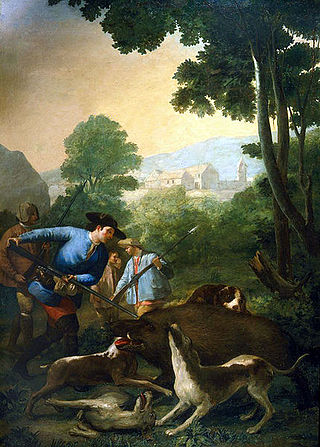
The Boar Hunt is a painting of 1775 by Francisco Goya and the earliest surviving tapestry cartoon by the artist. It depicts men with dogs and boar spears killing a boar.

Summer or The Threshing Floor is the largest cartoon painted by Francisco de Goya as a tapestry design for Spain's Royal Tapestry Factory. Painted from 1786 to 1787, it was part of his fifth series, dedicated to traditional themes and intended for the heir to the Spanish throne and his wife. The tapestries were to hang in the couple's dining room at the Pardo Palace.

Children in a Chariot is a 1779 painting by Francisco de Goya. It is part of the third series of cartoons he produced for tapestries at the Royal Palace of El Pardo; the tapestry in question was to be positioned over a door. The painting is in the Toledo Museum of Art, in Toledo, Ohio.

The Spanish royal collection of art was almost entirely built up by the monarchs of the Habsburg family who ruled Spain from 1516 to 1700, and then the Bourbons. They included a number of kings with a serious interest in the arts, who were patrons of a series of major artists: Charles V and Philip II were patrons of Titian, Philip IV appointed Velázquez as court painter, and Goya had a similar role at the court of Charles IV.

The Drunk Mason is an oil on canvas painted by Francisco de Goya, then reputed painter of tapestries for the royal palaces. It belonged to the fifth series undertaken by Goya, and, like all the pieces that compose it, was painted between 1786 and 1787.

The series of paintings for the alameda of the Dukes of Osuna comprises seven pictures painted by Francisco de Goya between 1786 and 1787. The country estate of the dukes and duchesses, who were the painter's mecenas and friends, was known as El Capricho, and was located on the outskirts of Madrid.

The tapestry cartoons of Francisco de Goya are a group of oil on canvas paintings by Francisco de Goya between 1775 and 1792 as designs for the Royal Tapestry Factory of Santa Barbara near Madrid in Spain. Although they are not the only tapestry cartoons made at the Royal Factory, they are much the best known. Most of them represent bucolic, hunting, rural and popular themes. They strictly adhered to the tastes of King Charles III and the princes Charles of Bourbon and Maria Luisa of Parma, and were supervised by other artists of the factory such as Maella and the Bayeu family. Most are now in the Museo del Prado, having remained in the Spanish Royal collection, although there are some in art galleries in other countries.

La novillada, is an oil painting by Francisco de Goya, painted in 1780, when he was trying his hand at bullfighting. It is part of the fourth series of tapestry cartoons for the Prince of Asturias' antechamber in the Pardo Palace.




















